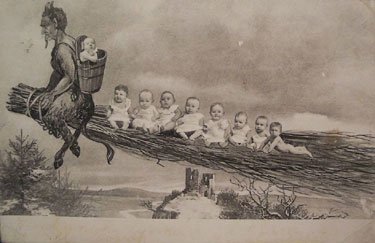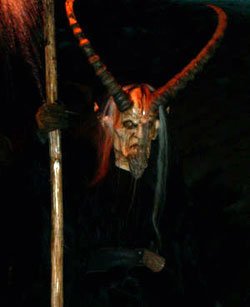Category Archive 'Folklore'
25 Oct 2022


Lithhub has an extensive excerpt from Nancy Marie Brown‘s recent book Looking For the Hidden Folk.
“Practically every summer,” wrote Icelandic ethnologist Valdimar Hafstein in the Journal of Folktale Studies in 2000, “a new legend is disseminated through newspapers, television, and radio, as well as word of mouth, about yet another construction project gone awry due to elven interference.” Unlike most urban legends, these are based on “the experience of real people involved in the events.”
That the news reports “are often mildly tongue-in-cheek” does not, in his opinion, “detract from the widespread concern they represent.” In August 2016, for example, an Icelandic newspaper printed the story “Elf Rock Restored after Its Removal Wreaks Havoc on Icelandic Town.” The previous summer a mudslide fell on a road in the town of Siglufjordur. While clearing the blockage, the road crew dumped four hundred cubic feet of dirt on top of a large rock known as the Elf Lady’s Stone.
The Elf Lady (illustrated on the paper’s English-language website as Cate Blanchett in the role of the elf queen Galadriel from The Lord of the Rings) was not happy, and a series of mishaps ensued. A road worker was hurt. A TV newscaster “sank into a pit of mud, right up to his waist and had to be rescued.” The river flooded the road, and the constant rain caused further mudslides. A bulldozer operator reported: “I had just gotten into the vehicle when I see a mudslide coming toward me, like a gigantic ball. When it hit the river flood it exploded and water and rocks went everywhere. We fled.” Then the bulldozer broke down. The Siglufjordur town council officially asked the Icelandic Road Administration to unearth the Elf Lady’s Stone. They complied. They also power hosed it clean.
Icelandic elf stories light up the internet: I found this one in the New York Times, Travel and Leisure, the Daily Telegraph, the Minneapolis Star Tribune, the CBC, Yahoo.com, and as far afield as the Philippine Daily Inquirer, among others. Many media outlets justify their interest by citing a series of surveys proving that, in Valdimar’s words, “elves are alive and frisky in modern day Iceland.”
In 1974, Icelandic psychologist Erlendur Haraldsson conducted a fifty-four-question survey on spiritual matters. Of those who responded, 15 percent considered elves likely to exist, 7 percent were certain they existed, and 5 percent had seen an elf. “A third of the sample,” Valdimar points out, “entertained the possibility of their existence (33 percent), neither affirming nor denying it.” A church historian in 1995 sought out people “with an interest in mysticism”: 70 percent of this sample thought elves existed, while only 43 percent believed that space aliens visited Earth. An Icelandic newspaper polled its readers on politics and government in 1998, slipping in the sly yes-or-no question, “Do you believe in elves?” Nine out of ten respondents answered the question. Of them, 54.4 percent replied yes.
In 2006 and 2007 the University of Iceland’s Department of Folkloristics entered the debate, with technical help from the university’s Social Science Institute. Their fifty questions were based on those of Erlendur in 1974, adapted for “a modern society that had been in contact with New Age thought,” according to folklore professor Terry Gunnell.
Again, 5 percent of the one thousand respondents said they had seen an elf, while more than 50 percent “entertained the possibility of their existence.” …
For Gunnell, the most striking result of the Icelandic surveys is that “in spite of the radical changes in Icelandic society” between 1974 and 2006, the Icelanders’ traditional beliefs about elves had “remained near static.” They were, he concluded, “deeply rooted.”
RTWT
12 Sep 2022


The Daily Mail reports:
The royal beekeeper – in an arcane tradition thought to date back centuries – has informed the hives kept in the grounds of Buckingham Palace and Clarence House of the Queen’s death.
And the bees have also been told, in hushed tones, that their new master is now King Charles III.
The official Palace beekeeper, John Chapple, 79, told MailOnline how he travelled to Buckingham Palace and Clarence House on Friday following news of The Queen’s death to carry out the superstitious ritual.
He placed black ribbons tied into bows on the hives, home to tens of thousands of bees, before informing them that their mistress had died and that a new master would be in charge from now on.
He then urged the bees to be good to their new master – himself once famed for talking to plants.
The strange ritual is underpinned by an old superstition that not to tell them of a change of owner would lead to the bees not producing honey, leaving the hive or even dying.
RTWT
Telling the Bees, Wikipedia entry.
21 Jan 2016


The Smith and the Devil
The Guardian reports that new research methods have disclosed the ancient roots of classic European fairy tales.
Fairy stories such as Beauty and the Beast and Rumpelstiltskin can be traced back thousands of years to prehistoric times, with one tale originating from the bronze age, academics have revealed.
Using techniques normally employed by biologists, they studied common links between 275 Indo-European fairy tales from around the world and found some have roots that are far older than previously known, and “long before the emergence of the literary recordâ€.
While stories such as Beauty and the Beast and Rumplestiltskin were first written down in the 17th and 18th century, the researchers found they originated “significantly earlierâ€. “Both tales can be securely traced back to the emergence of the major western Indo-European subfamilies as distinct lineages between 2,500 and 6,000 years ago,†they write.
Durham University anthropologist Dr Jamie Tehrani, who worked with folklorist Sara Graça da Silva, from New University of Lisbon, believed the research – published in the Royal Society Open Science journal – has answered a question about our cultural heritage. …
Some of these stories go back much further than the earliest literary record and indeed further back than classical mythology – some versions of these stories appear in Latin and Greek texts – but our findings suggest they are much older than that.â€
Analysis showed Jack and the Beanstalk was rooted in a group of stories classified as The Boy Who Stole Ogre’s Treasure, and could be traced back to when eastern and western Indo-European languages split – more than 5,000 years ago. Beauty and the Beast and Rumpelstiltskin to be about 4,000 years old. A folk tale called The Smith and the Devil was estimated to date back 6,000 years to the bronze age.
The story, which involves a blacksmith selling his soul in a pact with the devil in order to gain supernatural ability, then tricking the evil power, is not so well known today, but its theme of a Faustian pact is familiar to many.
The study employed phylogenetic analysis, which was developed to investigate evolutionary relationships between species, and used a tree of Indo-European languages to trace the descent of shared tales on it, to see how far they could be demonstrated to go back in time.
Tehrani said: “We find it pretty remarkable these stories have survived without being written. They have been told since before even English, French and Italian existed. They were probably told in an extinct Indo-European language.â€
Da Silva believes the stories endure thanks to “the power of storytelling and magic from time immemorialâ€.
06 Nov 2015


Ancient Origins:
[A] mummified hand found in Castleton, North Yorkshire, England is the only known ‘Hand of Glory’, a grotesque artifact meant to aid thieves in their work during the night, still in existence. This mummified hand supposedly has the power to “entrance humans†according to the Express. Hands of Glory were also a favorite tool for thieves and creative storytellers for over 200 years.
What the newspapers have claimed as the last Hand of Glory was first uncovered in 1935 inside the wall at a thatched cottage in Castleton by a stonemason and local historian named Joseph Ford. Ford is said to have immediately recognized the importance of the hand as a supernatural tool, so he gave it to the Whitby Museum for safekeeping soon after the discovery.
———————————–
Express:
A Hand of Glory is the preserved hand of a hanged convict, which was believed to have unique magical properties.
The preparation of such a grizzly souvenir was complicated. First, the hand of an executed felon had to be cut off while the body was still hanging from the gallows. The worse the crime, the more effective the magic.
Once the blood was drained, the hand was wrapped in a cloth (preferably the winding sheet of a freshly buried corpse) and, according to an old recipe: ‘pickled in salt, and the urine of man, woman, dog, horse and mare; smoked with herbs and hay for a month; hung on an oak tree for three nights running, then laid at a crossroads, then hung on a church door for one night’.
Finally, either the fingers were dipped in the fat of a gibbeted felon, or a candle from the same ingredient was placed in the hand.
Once it was ready, the hand was used by burglars to make their work easy and safe by ensuring their victims fell into a deep supernatural sleep. The candle was lit and, as the villains entered the property – now illuminated by the glow from the burning hand of glory – they chanted the following:
Let those who rest more deeply sleep,
Let those awake their vigils keep,
O Hand of Glory, shed thy light,
Direct us to our spoil tonight.
The magical qualities of the hand would enable the thieves to creep through the sleeping household, take all the swag they could carry, and make their getaway undisturbed.
———————————–
From The Ingoldsby Legend:
Now open lock
To the Dead Man’s knock!
Fly bolt, and bar and band!–
Nor move, nor swerve
Joint, muscle, or nerve,
At the spell of the Dead Man’s Hand!
Sleep all who sleep!– Wake all who wake!–
But be as the Dead for the Dead Man’s Sake!!”
21 Dec 2014

In Austria, when St. Nicholas arrives with gifts for good children, he is accompanied by Krampus, a hairy, horned and cloven-hoofed monster equipped with enormous fangs who carries a bundle of birch twigs to beat up on naughty children. Krampus was banned by the fascists in the 1930s for being too negative a symbol.
In the postcard above, a relatively benign version of Krampus is carrying unwary infants right away.
Wikipedia article.
Krampus: Santa’s Sadistic Sidekick

17 Mar 2008
Bryan Patrick Miller returns to the Emerald Isle in search of his mother’s family roots, and encounters more than one surprise.
I did finally arrive in Goleen, a tiny cluster of stucco homes with farmland on one side and the Atlantic Coast on the other. It’s literally a one-horse town; a gray mare stood tied to a post outside the pub. I figured my best option was to walk into the only store, which doubled as the post office, and ask the clerk to point me to the church, so I could look in the town records.
“The name’s Glavin,†I said, smiling. She recoiled, backing away with a hand to her face, and wouldn’t say another word.
By the time I made it to Goleen’s dimly lighted pub, word seemed to have spread that a Glavin was back. Gnarled farmers glowered at me over their Guinnesses. No one spoke to me. I swallowed my pint fast and walked out.
Read the whole thing.
24 Oct 2007

Press reports of the sinister appearance of nooses as threats or as a form of racial initimidation are suddenly everywhere.
7 Eyewitness News today offers a typical example:
Authorities are investigating the third apparent hate crime at New York City schools– in just the last two weeks. A noose was found hanging from a tree in a playground in Queens yesterday– one day after a principal in Brooklyn received a noose in the mail.
——————————————————
And politicians are responding with a rash of proposed laws, some making displaying a noose a hate crime and a felony.
——————————————————
The problem is that, until this September, when leftwing coverage of the so-called Jena Six having spread to Black talk radio finally reached the mainstream media, no one thought of nooses as a racial symbol at all.
But, in the customary media avalanche fashion, a false statement was published by the first paper, and was repeated by the second, and before very long, a considerable body of public record exists attesting to validity and universal acceptance of another piece of arrant nonsense.
But the indefatigable Michelle Malkin is on the case, thank goodness, using her bully pulpit to republish a Christian Science Monitor article by Craig Franklin, which notes that just about the entire Jena Six story is a myth from top to bottom.
By now, almost everyone in America has heard of Jena, La., because they’ve all heard the story of the “Jena 6.” White students hanging nooses barely punished, a schoolyard fight, excessive punishment for the six black attackers, racist local officials, public outrage and protests – the outside media made sure everyone knew the basics.
There’s just one problem: The media got most of the basics wrong. In fact, I have never before witnessed such a disgrace in professional journalism. Myths replaced facts, and journalists abdicated their solemn duty to investigate every claim because they were seduced by a powerfully appealing but false narrative of racial injustice. …
Myth 1: The Whites-Only Tree. There has never been a “whites-only” tree at Jena High School. Students of all races sat underneath this tree. When a student asked during an assembly at the start of school last year if anyone could sit under the tree, it evoked laughter from everyone present – blacks and whites. As reported by students in the assembly, the question was asked to make a joke and to drag out the assembly and avoid class.
Myth 2: Nooses a Signal to Black Students. An investigation by school officials, police, and an FBI agent revealed the true motivation behind the placing of two nooses in the tree the day after the assembly. According to the expulsion committee, the crudely constructed nooses were not aimed at black students. Instead, they were understood to be a prank by three white students aimed at their fellow white friends, members of the school rodeo team. (The students apparently got the idea from watching episodes of “Lonesome Dove.”) The committee further concluded that the three young teens had no knowledge that nooses symbolize the terrible legacy of the lynchings of countless blacks in American history. When informed of this history by school officials, they became visibly remorseful because they had many black friends. Another myth concerns their punishment, which was not a three-day suspension, but rather nine days at an alternative facility followed by two weeks of in-school suspension, Saturday detentions, attendance at Discipline Court, and evaluation by licensed mental-health professionals.
——————————————————
Of course, it’s not really surprising that the teen-age pranksters “had no knowledge that nooses symbolize the terrible legacy of the lynchings of countless blacks in American history.” That particular identification would only have been made (before last September) by hyper-racially-sensitive obsessives. The lynching of blacks in the post-Civil War pre-WWII era is commonly treated as a key feature of the American catalogue of racial crime, but the reality is that lynchings were equal opportunity forms of mob justice.
Lynchings occurred as spontaneous outbursts of public indignation over particularly objectionable crimes, in which a suitable quorum of the community assembled proved unwilling to wait for legal due process to unfold, and having –rightly or wrongly– concluded the suspect’s guilt was incontrovertible, simply proceeded without further ado to the immediate application of justice.
Nor was lynching a unique feature of the segregated American South. As recently as 1933, there was a lynching in the San Francisco Bay area, following a kidnap-murder in San Jose. The perpetrators wound up dangling from the recently-completed (1929) San Mateo-Hayward Bridge.
/div>

Feeds
|










